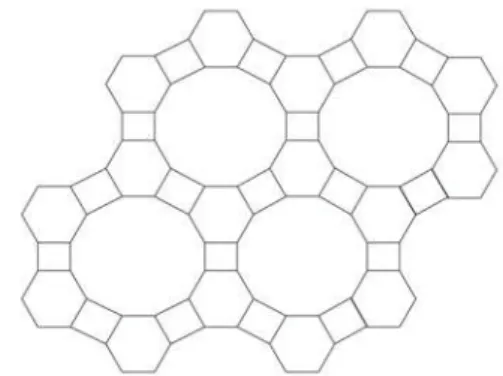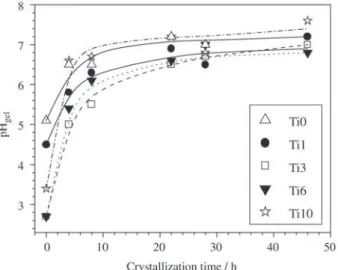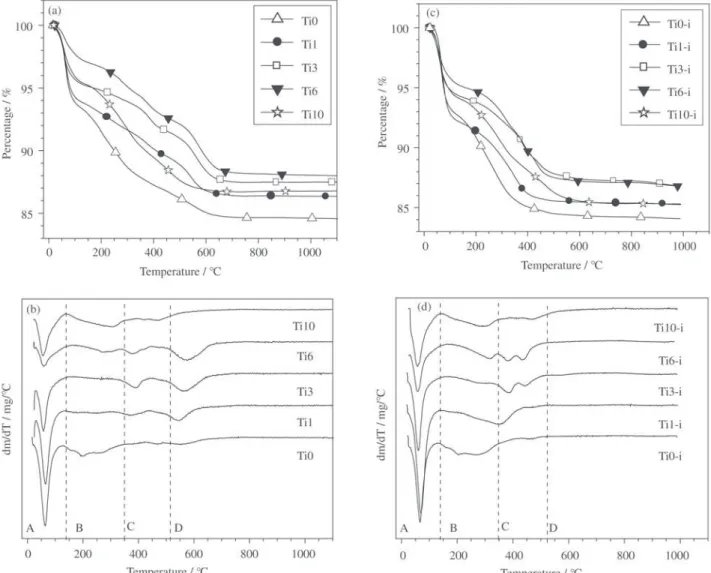*e-mail: dilson@power.ufscar.br
Synthesis and Characterization of the TAPO-5 Molecular Sieve
Sarah P.O. Rios, Ricardo Pereira and Dilson Cardoso*
Universidade Federal de São Carlos,
Programa de Pós-Graduação em Engenharia Química - Laboratório de Catálise Rodovia Washington Luís, Km 235, C.P. 676, 13565-905 São Carlos - SP, Brazil
Received: September 27, 2001; Revised: July 10, 2002
Aluminophosphate sieves with AFI structure substituted by Ti (denominated TAPO-5) have been synthesized hydrothermally. These materials were characterized by X-ray diffraction (XRD), chemical analysis (ICP), scanning electronic microscopy (SEM), ultraviolet diffuse reflectance spectroscopy (DRS-UV) and thermogravimetric analysis (TGA). XRD results showed the materi-als have good TAPO-5 crystallinity, although DRS-UV spectra indicated anatase phase as con-tamination. TGA analysis showed mass loss in the range of high temperatures, which can be attributed to protonated template decomposition. This indicates the existence of structural charge as a consequence of Ti incorporation into AFI structure
Keywords: molecular sieves, AFI, TAPO-5, titanium aluminophosphates, synthesis
1. Introduction
Zeolites or zeotypes became very important materials in catalysis since their capacity to separate substances ac-cording to size and shape was observed. The structures of these materials are very varied and in general, they are the same for aluminophosphates and aluminosilicates (zeolites). However, there are some structures that exist for aluminophosphates and derivates, but do not for zeolites, as the case for the AFI structure (Fig. 1). This structure is constituted by the union of the six members rings with the four members rings and is too easy to obtain as alumino-phosphate, but very hard to synthesize as silicate1 (zeolite SSZ-24).
The aluminophosphates are formed by intercalation of [AlO4-] and [PO
4
+] tetrahedral and don’t have net charge in
their structures. The isomorphous substitution of these tet-rahedral for an other, like [MgO4-2] or [TiO
4], can create an negative charge in the framework and change drastically the properties of the material (Fig. 2).
When investigators of Enichem industry synthesized TS-1, a molecular sieve containing titanium in its MFI struc-ture2, and identified its catalytic advantages in heterogene-ous oxidation, there was an increase in the research for other molecular sieves containing transition metals in their struc-ture. So, the interest in synthesizing
titanium-alumino-phosphate arose by the fact that they can be used in hetero-geneous oxidations and have some different properties com-pared to TS-1, namely, higher microporous diameter and hydrophilicity.
The incorporation of titanium in the AFI aluminophosphate forms TAPO-5 and the synthesis of this material involves generally the use of Ti organic sources3-8. As these compounds hydrolyse very easily, sometimes the TAPOs have TiO2 anatase as contaminant phase. Zahedi-Niaki et al. synthesized TAPO-5 with different Ti contents, but the incorporation of this element in the solid was very low9.
In order to avoid the use of the unstable Ti organic sources, the present work verifies the possibility of using hexafluorotitanic acid as Ti source for the synthesis of TAPO-5, as well the possibility of incorporating different Ti contents in the AFI structure.
2. Experimental Procedure
Synthesis
Titanium-aluminophosphate samples were synthesized hydrothermally under autogenous pressure, with
xTiO2:(1-x/2)Al2O3:P2O5:TEA:100H2O:6xHF as molar com-position of the synthesis reaction mixture, where x = 0; 0.01; 0.03; 0.06 e 0.1. The H2TiF6 solution (5% w/w) was pre-pared from the reaction between HF (Carlo Erba, 50%) and TiO2 (Degussa Hülls). The Al2O3 source was pseudoboehmite (Condea) and that of P2O5 was phosphoric acid (Carlo Erba, 85%) and TEA is the triethylamine (Carlo Erba, 99.5%) used as AFI structure template. The autoclaves containing the reaction mixtures were submitted to 170 °C and removed in different crystallization times (tc = 4; 8; 22; 28 and 46 h). The solids were centrifuged and washed sev-eral times, dried at 110 °C and codified (TixTy, where x
indicates the Ti contents, Ty = crystallization time. For the samples which code has no information about the crystalli-zation time, means that Ty = 46 h). The crystallinity was determined by the sum of the peaks areas at around 2θ = 14.8; 19.7; 21.0 and 22.0°.
In a typical gel preparation, using x = 0.03, 10.73 g of pseudoboehmite were dispersed in 32 ml of deionized
wa-ter and stirred overnight. Then, 9.5 ml of the phosphoric acid diluted in 72 ml of water was added to the dispersed pseudoboehmite and maintained under stirring during 1 h. Subsequently, 9.7 ml of TEA were added to the mixture, and finally, after stirring during 0.5 h, 1.8 ml of 5% w/w H2TiF6 solution diluted in 10 ml of water were added and stirred for more 0.5 h. The final mixture was equally di-vided in five 70 ml autoclaves and crystallized at 170 °C as already specified. The samples code is indicated in the Ta-ble 1.
Characterization
The samples were analyzed by powder X-ray diffrac-tion (XRD, Rigaku-GeigerFLEX) in a scan range of 2θ
be-tween 3 and 40° using a scan speed of 2 °/min and Cu-Kα
as X-ray source.
Ti, Al and P contents were measured by chemical analy-sis through ICP methods (Thermo Jarrel Ash), dissolving 0.1 g of the solids in 4 ml HCl (Mallinckrodt, 37%) and 2 ml HNO3 (Mallinckrodt, 65.5%) mixture. The solution was finally diluted in a 100 ml volumetric flask.
The micrographs of the samples were obtained from scanning electron microscopy (Zeiss, model DSM-940-A). For this purpose, some drops of the sample dispersed in acetone were placed in a sample holder, dried and coated with gold.
Diffuse reflectance spectra in the UV region were re-corded from a Varian Cary 5 UV-Vis-NIR spectrophotom-eter and plotted using Schuster-Kubelka-Munk function (SKM)10 against BaSO
4 as reference. The SKM equation is:
F(R∞) = (1- R∞)
2/2R
∞ (1)
where, R∞ is the relation between the light intensity reflected
from the sample and the light intensity reflected from the reference. This equation is more adequate for quantitative analysis of spectra obtained by diffuse reflectance than the Lambert-Beer equation.
Thermogravimetric analysis (SDT 2980 Simultaneous DSC-TGA) was done in oxidant as well inert ambient with a gas flux of 100 ml.min-1 air and 30 ml.min-1 of nitrogen.
Figure 2. Isomorphous substitution on an AlPO structure: a) [PO4+]
by [ElO4] and b) both [PO4+] and [AlO 4
-] by 2[ElO 4].
Table 1. Chemical analysis of TAPO-5 containing different Ti contents synthesized with 46 h.
Sample x Xgel Xs Ys Zs [(P+Ti)/Al]s [(P+Ti)/(Al+Ti)]s
Ti1 0.01 0.0025 0.004 0.487 0.509 1.0534 1.0448
Ti3 0.03 0.0075 0.0060 0.486 0.508 1.0576 1.0447
Ti6 0.06 0.0150 0.023 0.472 0.505 1.1186 1.0667
Ti10 0.10 0.0250 0.0280 0.469 0.502 1.1301 1.0664
The temperature range of TGA measurements was from 25 °C up to 1000 °C, using a heating rate of 10 °C.min-1.
3. Results and Discussion
Figure 3 presents the pH of the reaction mixture as a function of the crystallization time. It can be observed that the gel pH increases with crystallization time up to a maxi-mum value of around 7. This can be explained through the consumption of phosphoric acid by pseudoboehmite (an insoluble hydroxide) during the crystallization. Exception to samples mixture Ti10Ty, there was a tendency of decreas-ing of the pH of reaction mixture as the Titanium contents
increases. This tendency could be a consequence of the fact that the Titanium source is an acid (hexafluorotitanic).
Figure 4 illustrates the crystallinity of the TAPO-5 sam-ples as a function of the crystallization time. It can be ob-served that the crystallinity increases rapidly in the first hours and reaches a level value, which increases as the Titanium content is higher up to x = 0.06. This increasing in crystal-linity, as the isomorphic substitution increases, was also observed during the incorporation of other elements in AlPOs as Mg11 or Co12. However, as observed during the incorporation of these two elements, also in the case of Ti-tanium there is a limit for the crystallinity and the maxi-mum value for x = 0.10 was lower than that of x = 0.06.
Figure 5 shows the X-ray patterns of several titanium-substituted AFI samples, prepared with 46 h of crystalliza-tion. The patterns are very similar to that reported4, indicat-ing that there aren’t other phases, except the sample Ti3, which presented some tridimite as contaminant. It was re-ported13 that, when the pH during the synthesis of crystal-line aluminophosphates is below 3.0, it could origin dense phases and when the pH is above 10.0 it could dissolve the product or precipitate some metal hydroxides. This could be the reason for the contamination, since TAPO-5 samples synthesized with x = 0.03 and 0.06 presented an initial pH below 3.0. However, only Ti3 (TAPO-5, x = 0.03) exhib-ited tridimite as contaminant phase.
The Table 1 presents the chemical analysis of TAPO-5 samples synthesized with 46 h and compares them with the gel composition.
This Table 1 illustrates that the Ti and P molar fraction in the solid is higher than in the gel. This indicates that Figure 3. pH of the reaction mixture containing different Ti
con-tents as a function of the crystallization time.
Figure 4. Crystallinity of the TAPO-5 samples as a function of the crystallization time.
aluminum forms soluble complexes in the presence of the template.
Figure 6 shows micrographs of TAPO-5 samples syn-thesized with different Ti contents and 46 h crystallization. It can be observed that the particles of the material are formed by aggregates, and the morphologies changes as the Ti contents in the reaction mixture increases. The aggre-gates obtained from the mixtures with the lower Ti content are compact and have a external rounded shape4, while the one formed from mixture with higher Ti are formed by hex-agonal needles-like crystals6,9.
Figure 7 and Table 2 present the DRS-UV results from TAPO-5. The signal at 211 nm is attributed to Ti (IV) spe-cies in framework tetrahedral positions. The origin of the signal at around 261 nm is not yet well established. Some authors4 suggest they are originated by the presence of oc-tahedral framework Ti, others8 to the presence of extraframework TiO2 species (di- and trimers). One of the principal phases, which contaminate Ti-molecular sieves, is TiO2 in the form of anatase4 whose UV signal appears around 320 nm. The samples of TAPO-5 synthesized in this
Figure 7. DRS-UV from TAPO-5, with 46 h of crystallization and different Ti contents.
Figure 6. Micrographs of TAPO-5, with 46 h crystallization (a) Ti1, (b) Ti3 and (c)Ti10.
Table 2: DRS-UV bands of TAPO-5.
UV (200-400 nm)
FTa FOb Ac
Ti0 210 250 absent
Ti1 211 259 312
Ti3 212 258 293
Ti6 211 263 308
Ti10 211 258 298
Ti sites: a framework tetrahedral; b framework octahedral; c anatase.
work showed a 3rd signal in the region of about 300 nm, which could be assigned to this phase. AlPO-5, that means, the sample that has no Ti its composition (Ti0, x = 0.0), has also signals in the UV region, at about 210 and 250 nm. Zanjanchi and Rashidi14 attributed these signals to charge transfer from O → Al and to the presence of template
oc-cluded in the channels of the AFI framework. So, in the spectra of samples containing Ti, besides the signals involv-ing this element, there are also these two contributions.
Figure 8 shows the thermograms of TAPO-5 (and the derivatives) measured under oxidant (Figs. 8a and 8b) and inert (Figs. 8c and 8d) ambient.
The thermograms measured under oxidant atmosphere present four temperature ranges (A, B, C and D) associated to different weight loss processes. The first range A
(T < 150°C) is attributed to water loss. The range B
Figure 8. Thermograms of TAPO-5 in oxidant atmosphere: a) TGA, b) corresponding DTG; and inert atmosphere: c) TGA, d) corre-sponding DTG.
(150 < T < 320°C) is associated to desorption of the physi-cally occluded template or decomposition of
alkylammonium phosphates11. The range C
(320 < T < 520°C) is ascribed to the decomposition of protonated template, which is compensation cation of the charge originated by the isomorphic substitution of frame-work [PO4+] by [TiO
4]. The temperature range D (T > 520°C) is attributed to coke oxidation, formed from de-composition of protonated template. This attribution is con-firmed by the absence of this weight loss in the thermograms obtained under inert atmosphere. The weight loss in the tem-perature ranges A, B, and C were also found in the thermograms obtained under inert atmosphere and the tributions are the same of that measured under oxidant at-mosphere.
4. Conclusions
Using various characterization techniques, it was possi-ble to observe the influence of Ti content on the properties of microporous crystalline aluminophosphates with AFI structure, synthesized using a new Ti source (hexa-fluorotitanic acid). The XRD showed that the product ob-tained using this Ti source was not very different from the product using the organic sources. However, DRS-UV showed that using hexafluorotitanic acid there was forma-tion of anatase at lower Ti content, compared when to Ti-organic sources are used. The thermogravimetry showed the presence of protonated template in the samples contain-ing Ti, which compensates the negative charges in the AFI framework, formed as a consequence of the isomorphic sub-stitution of [PO4+] by [TiO
Acknowledgements
We acknowledge to CAPES and PRONEX/CNPq for financial assistance, to ‘Laboratório de Caracterização Eletrônica’ (LCE) for the use of the SEM and to ‘Laboratório Interdisciplinar de Eletroquímica e Cerâmica’ (LIEC) for the use of the DRS-UV equipment.
References
1. Bialek, R.; Meier, W.M.; Davis, M.; Annen, M.J. Zeolites, v. 11, p. 438, 1991.
2. Taramasso, M.; Perego, G.; Notari, B. U.S. Patent, 4,410,501, 1983.
3. Ulagappan, N.; Krishnasamy, V.K. J. Chem. Society: Chem. Communication, p. 373,1995.
4. Ulagappan, N.; Krishnasamy,V. Indian J. of Chemistry, 35A, p. 920, 1996.
5. Prakash, A.M.; Kurshev, V.; Kevan, L. J. Phys. Chemis-try B., n. 101, p. 9794, 1997.
6. Akolekar, D.B.; Ryoo, R.J. Chem. Society: Farad. Trans., n. 92 (22), p. 4617, 1996.
7. Zahedi-Niaki, M.H.; Zaidi, S.M.J.; Kaliaguine, S.
Microporous and Mesoporous Materials, n. 32, p. 251, 1999.
8. Zahedi-Niaki, M.; Kapoor, M.; Kaliaguine, S. J. of Ca-talysis, n. 177, p. 231, 1998.
9. Zahedi-Niaki, M.H.; Joshi, P.N.; Kaliaguine, S. Progress in Zeolite and Microporous Materials. Studies in Sur-face Science and Catalysis, Elsevier Science B. V., v. 105, p. 1013, 1997.
10. Schoonheydt, R.A. in Characterization of Heterogene-ous Catalysts - Chemical Industries , v. 15. Edited by Francis Delannay, p. 125-160, 1984.
11. Rios, S.P.O; Giotto, M.V.; Cardoso, D. 10° Congresso Brasileiro de Catálise, v. 2, p. 392, 1999.
12. Shiralkar, V.P.; Saldarriaga, C.H.; Perez, J.O.; Clearfield, A.; Chen, M.; Anthony, R.G.; Donohue, J.A. Zeolites, v. 9, p. 474, 1989.
13. Wilson, S.T. Introduction to Zeolite Science and Prac-tice Elsevier Science Publishers B. V. Amsterdam, p.137, 1991.
14. Zanjanchi, M.A.; Rashidi, M.K. Spectrochimica Acta




